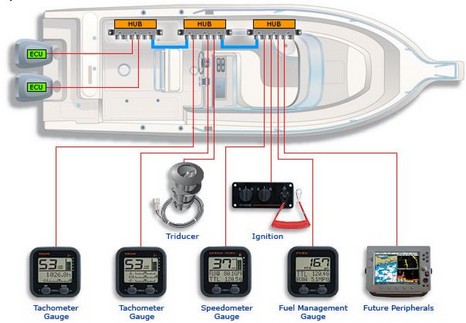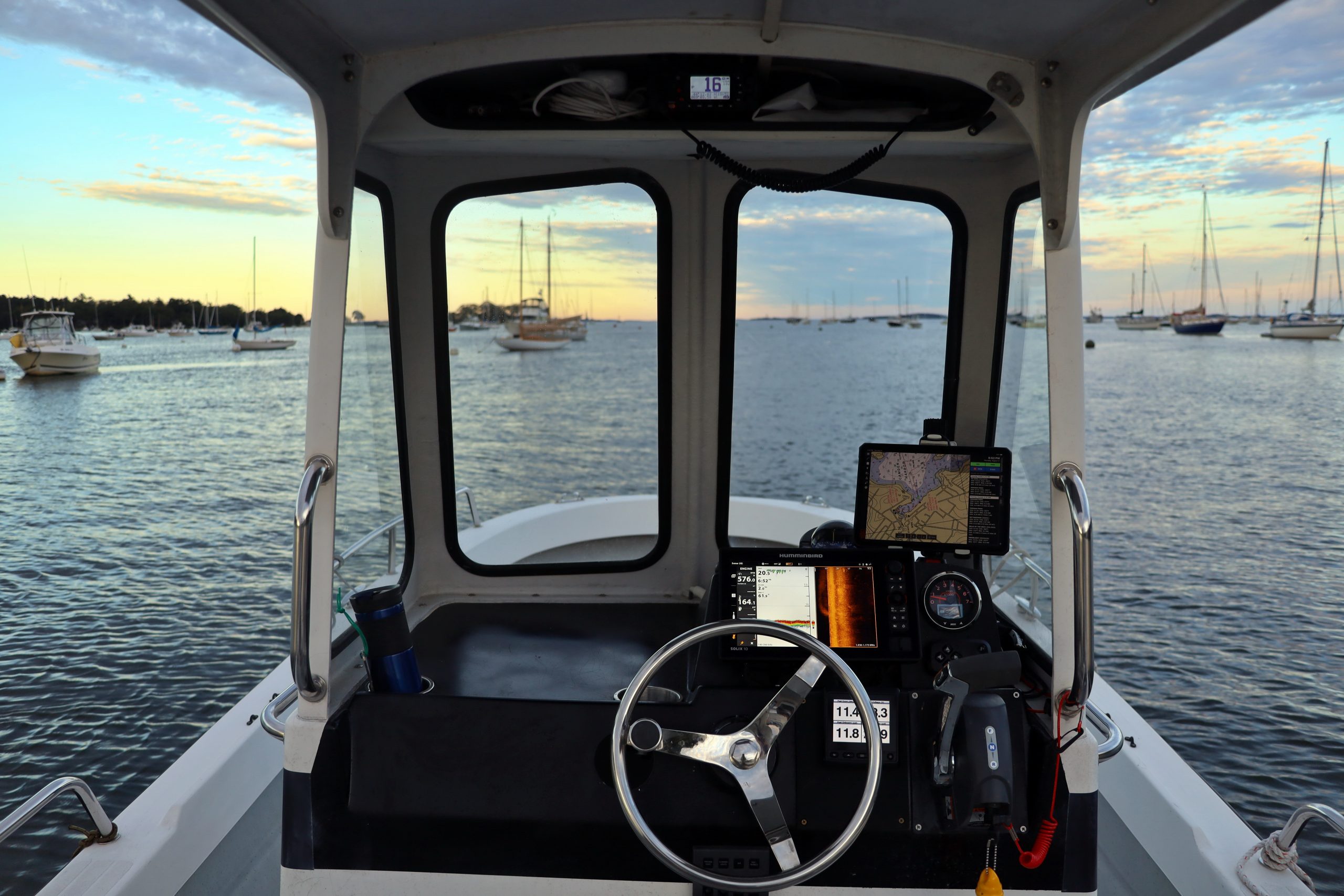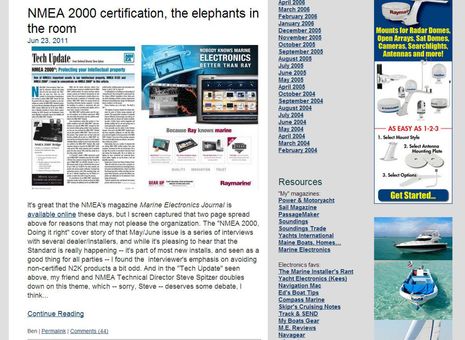Yamaha Command Link, NMEA 2000 or not?

Yesterday commenter JC asked how to connect his new Yamaha F250 to a Garmin 5212. The answer is a little less definite than I thought. I certainly remember Yamaha talking about how their coming CANbus engine system, Command Link, would be NMEA 2000 compatible—can even find a company reference as recent as last year—but check out the official Command Link Web pages, and see if you can find a single mention of NMEA 2000! Strange.
But Jim at Continuous Wave confirms my recollections, and NMEA itself shows that Yamaha’s Command Link gauges are indeed N2K certified. Then there’s that Raymarine “Future Peripheral” in the diagram above, and, finally, the fact that Maretron sells a Command Link to N2K patch cable (though it’s only listed on their price list PDF, and for some reason costs a whopping $125). My guess: Yamaha hasn’t yet certified its engine ECU and is hence being very careful with its claims. (The desire to sell expensive accessories, like that triducer, would be a skeptical alternative explanation.) At any rate, if I were JC I’d try the patch cable (maybe first checking that Maretron will take it back if the engine doesn’t actually talk to the Garmin). If you do, JC, please report back here about how it works.
PS, some valuable, if also depressing (and anonymous) feedback:
Yamaha engines will work on NMEA2000-compatible products; I’ve done it – more than once. And you don’t need to spend that much money. If you have a Command Link system on the boat (engines 115 hp and greater with mfg date since May 06, last I knew), you can buy one of the Yamaha inter-connect cables that goes from hub to hub (< $20 or something similar). Cut it in half or cut connector off one end. The five wires are even color coded appropriately to NMEA2000 standards. This can be wired into whatever connector your equipment needs.
Yamaha is having the same concerns as everyone else connecting to NMEA2000 network… what am I liable for by being “compatible” with this standard. As I have experienced, when someone new comes on the bus (or even someone not new like Maretron where they had a number out of range in one of their software versions), it may or may not knock over your display/engine/etc. – whether you believe your unit to be “robust” or not. I am not confident you will see Yamaha officially certify and claim wide compatibility… I’ve grown to believe that maybe Mercury are right and not wrong on the whole open standard issue…













Just a guess here … maybe that “triducer” is a Maretron DST100, and the patch cable is to connect the DST100 to the Yamaha Hub ?
I worked in the computer industry during the early days of computer networks. The same questions were raised by management and bean counters – liability, what ifs, ” We do not control the network, so how can we guarantee interoperatability”, etc.
InstallFests helped prove interoperability and clarify standards interpretations, open free standards helped also – look at the Internet RFC “standards’ process”. Licenses to use helped also – basically users agreed to accept certain legal restrictions in exchange for using the technology.
One of the problems with the NMEA 2000 standard is the absurd cost of the standard. If it were freely available, a lot more NMEA 2000-related hardware and software development would occur, a lot more eyes would look at the standard and find the ambiguities and gray areas, raise interpretation requests, etc.
“One of the problems with the NMEA 2000 standard is the absurd cost of the standard”
… it would seem the way they have gone about things has assured themselves no access to cheap labor. I would imagine for the absurd price they charge, they are still cash poor as a function of keeping the spec closed and as a result severly underfund many of the efforts that are needed for the spec to florish, that other organizations have taken care of for free by interested parties in the industry and the user base.
Maybe one of us should try to get elected as chairman or hired as executive director/president, and bring the right vision to the specification process and licensing model.
I vote for Ben.
Liability is a real concern with any open system, that is the weakness. There is also the issue of support, you do not want to be spending lots of money on field service personnel just to learn that some other (possibly a competitor’s) product is causing your engine to fail.
In the computer world I have learned that nothing works unless it is tested. A truly open network cannot be completely tested, especially when new devices are added. That is the weakness of open systems — you would not want to fly on an airplane built up out of supposedly compatible parts ordered by the Airline company’s beancounters. We only fly because we know that the exact configuration of plane that we are stepping into has been certified by the FAA as “airworthy.”
This is not to knock open systems, especially for navigation. It is absolutely great that I can mix-and-match parts, possibly saving a buck or two in the process. I’m just trying to provide some perspective for why an engine company may be reluctant to jump onto the bandwagon. Engines are life critical devices, and have to be held to a different standard than the electronic toys that we all love.
That sounds very compelling … but I believe in this case with Yamaha the entire network can go down, even the battery can die, and the engine still starts/stops, rotates, and throttle controls work perfectly. Normally those things are put on mechanical linkages or extremely simple robust dedicated wiring for each function, that are not intermixed with engine sensors such as temp sensors or tach senders.
I think our open systems debate is therefore still valid and extendable to engine manufacturers.
Yamaha Command Link, NMEA 2000 or not?
I called Maretron for that command link to Nmea2000 cable, the answer was that Yamaha prohibit them to sell the cable.
Now I’m making my own cable
One problem
The garmin 5212 doc on the NMEA2000 port pinout is 0,same for command link
Thanks
JC
I had a somewhat surprising discussion with Simrad about their IS-12 instruments. They are NMEA 2000 but I was pretty strongly discouraged from expecting them to work with any non-Simrad NMEA 2000 sensors. Although I got no guarentee that the IS-15 (NMEA 0183) instruments would work with other sensors it was pretty strongly hinted that I should go that route if I wanted interoperability.
Naive as I am, I would have thought the opposite. The whole point of seeking out NMEA 2000 instruments is that it is supposed to be a better spec with certification and all that jazz to give you some confidence that company A’s sensor will work with company B’s meter. It doesn’t seem to be working out that way — yet, at least.
It doesn’t really sound as if the companies are fully onboard to make the systems work. Garmin has a partial implementation. Yahama pretends that their system is not NMEA 2000, and Simrad flat out discourages the use of it. It really goes back to my earlier post; nobody wants to support hybrid networks because they don’t want to debug the ‘other guys’ system.
I’m not sure that I would try to get around Yamaha’s reluctance to expose their network. You never know what their testing has revealed since they announced that they would support it someday. I’d wait until their boffins are satisfied that it is safe. All electronic devices are fail-safe — until they fail!
b393capt wrote earlier “Just a guess here … maybe that “triducer” is a Maretron DST100, and the patch cable is to connect the DST100 to the Yamaha Hub ?”
… seems like this might be correct.